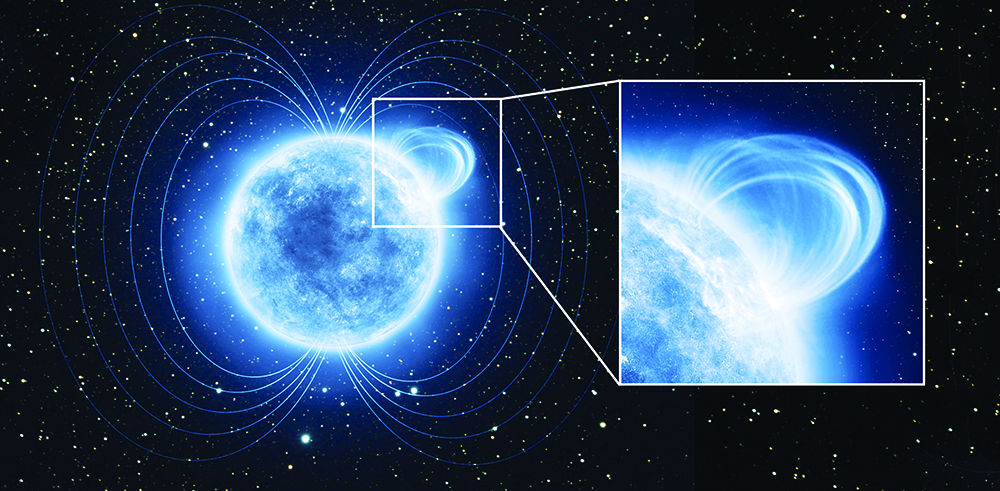Strange 'Magnetic Monster' Found Lurking Inside Dead Star

Hiding in the recesses of a dead star is an ultra-strong magnetic field bursting from its surface in the form of X-rays, astronomers report.
The surprising nature of the object SGR 0418+5729 was revealed after three years of observations by several telescopes that initially showed a weak magnetic field there.
Uncovering the "magnetic monster," as European Space Agency officials described the star in a statement, required a new analytical technique. If confirmed, the find could rewrite scientists' understanding of how magnetic fields form and are amplified in other neutron stars, which are the leftovers from star explosions. [The Top 10 Star Mysteries Ever]
Magnetic mystery
SGR 0418, as the neutron star is known in its short form, is the core of a huge star that used up all of its fuel and exploded as a supernova. Neutron stars are so dense that a teaspoon full of material would weigh about 10 million tons, scientists say.
Some neutron stars (such as SGR 0418) are also magnetars, so called because they have immense magnetic fields. But when SGR 0418 was first discovered in June 2009, scientists believed the object actually had one of the weakest magnetic fields ever detected: 100 times lower than the usual magnetar.
"Understanding these results was a challenge," lead researcher Andrea Tiengo, an astronomer at the University Institute of Advanced Studies in Italy (Istituto Universitario di Studi Superiori), said in a statement. "However, we suspected that SGR 0418 was in fact hiding a much stronger magnetic field, out of reach of our usual analytical techniques."
Get the Space.com Newsletter
Breaking space news, the latest updates on rocket launches, skywatching events and more!
Tiengo's team thus applied a new method to measure the object's magnetic field. The traditional way with magnetars, which rotate every few seconds, is to look at how much a star's spin rate declines over time. But in this case the researchers instead examined variations in SGR 0418's X-ray emissions during its nine-second rotation. Scientists then noticed SGR 0418's X-ray brightness falling off suddenly at one spot in its rotation, which they took to mean that something is absorbing the X-rays.

The force becomes strong with this one
The new observations suggest that in small regions of SGR 0418 — which could be only a few hundred feet across — X-rays are being absorbed by protons covering the surface. These positively charged particles are trapped in a small area because of a strong magnetic zone beneath the magnetar's surface.
If the magnetic field is twisted, as the researchers believe it is, it could behave similarly to strong magnetic regions on Earth's sun. In the sun's case, these regions produce flares. On SGR 0418, a pulse of X-rays would occur when the magnetic field builds up below, then temporarily breaches the surface when the pressure reaches a certain point.
"This magnetar has a strong magnetic field inside it, but it is hidden beneath the surface," said Silvia Zane, a co-author of the study and a reader at University College London's space science laboratory. "The only way you can detect that is to find a flaw on the surface, where the concealed magnetic field can leak out."
The study was based on observations with the European Space Agency's XMM-Newton X-ray space telescope. The results were published in the Aug. 14 edition of the journal Nature.
Follow Elizabeth Howell @howellspace, or SPACE.com @Spacedotcom. We're also on Facebook and Google+. Original article on SPACE.com.
Join our Space Forums to keep talking space on the latest missions, night sky and more! And if you have a news tip, correction or comment, let us know at: community@space.com.

Elizabeth Howell (she/her), Ph.D., was a staff writer in the spaceflight channel between 2022 and 2024 specializing in Canadian space news. She was contributing writer for Space.com for 10 years from 2012 to 2024. Elizabeth's reporting includes multiple exclusives with the White House, leading world coverage about a lost-and-found space tomato on the International Space Station, witnessing five human spaceflight launches on two continents, flying parabolic, working inside a spacesuit, and participating in a simulated Mars mission. Her latest book, "Why Am I Taller?" (ECW Press, 2022) is co-written with astronaut Dave Williams.
